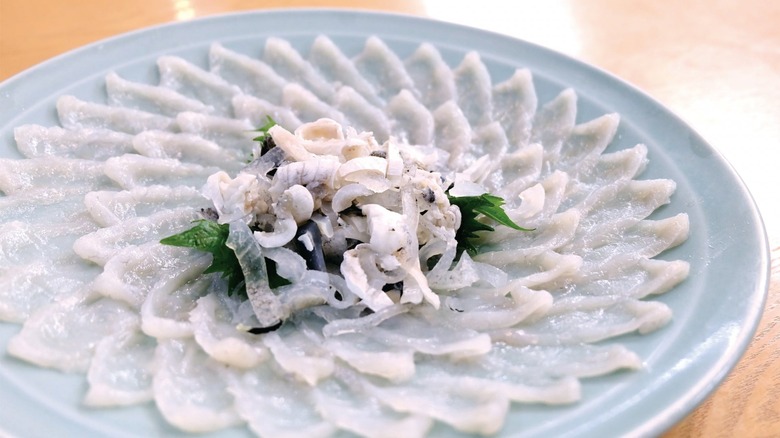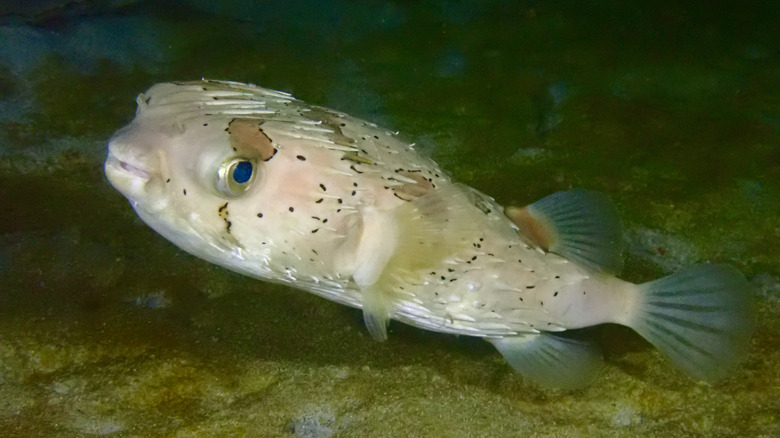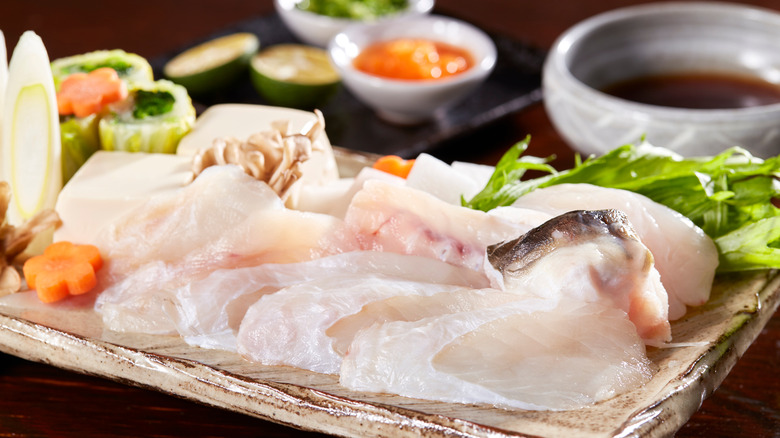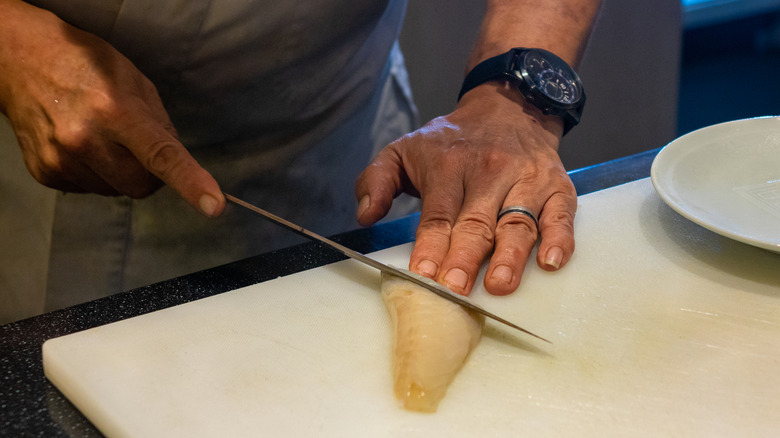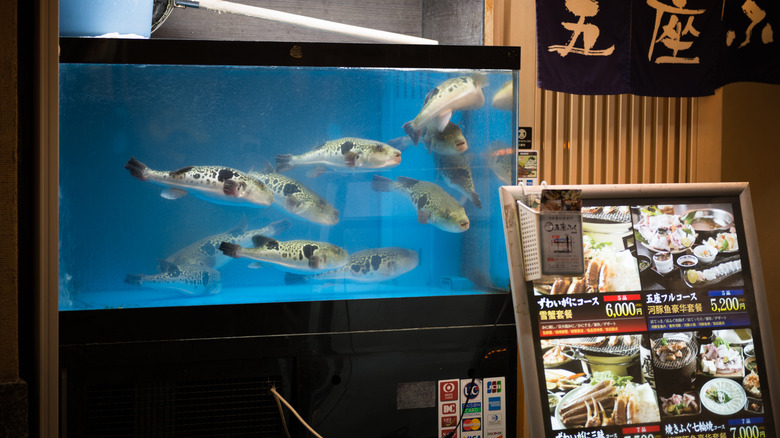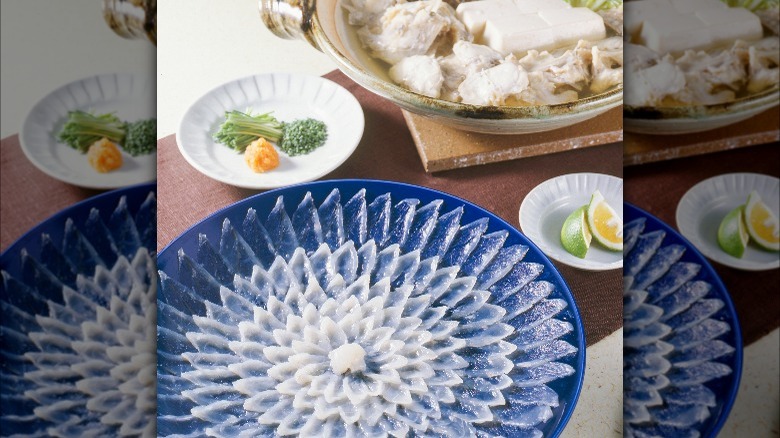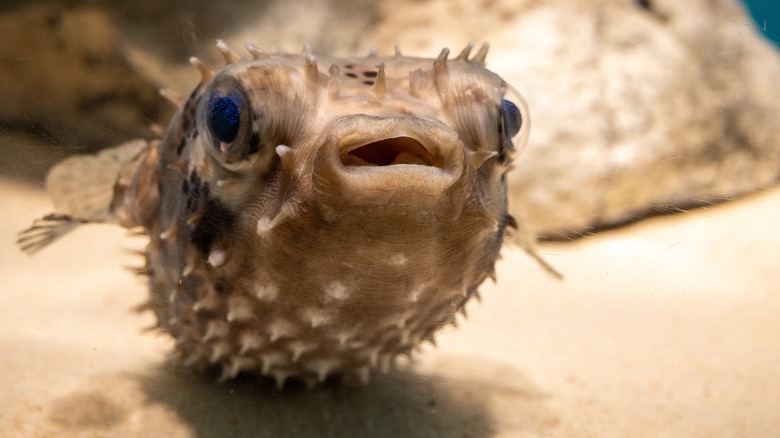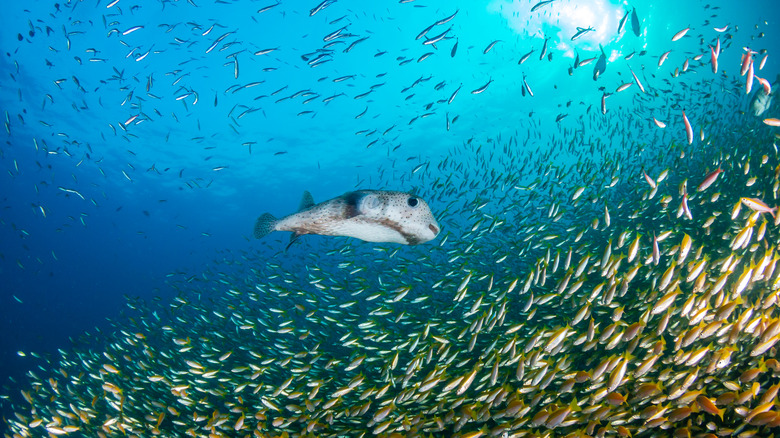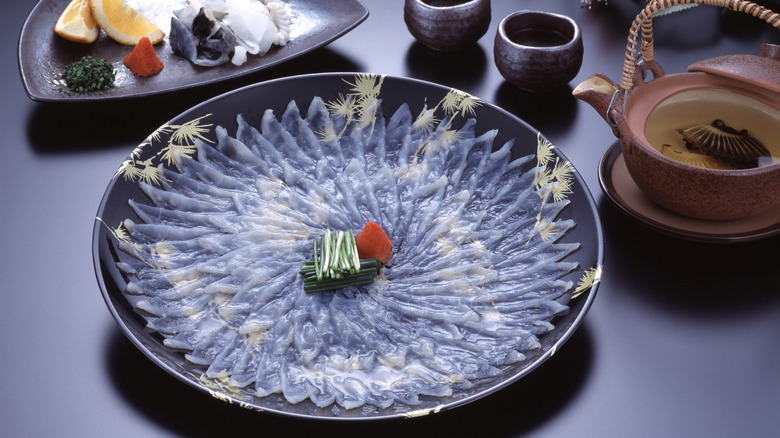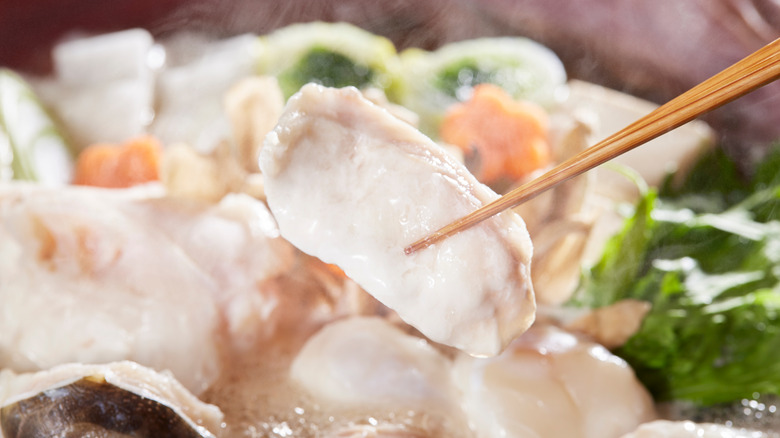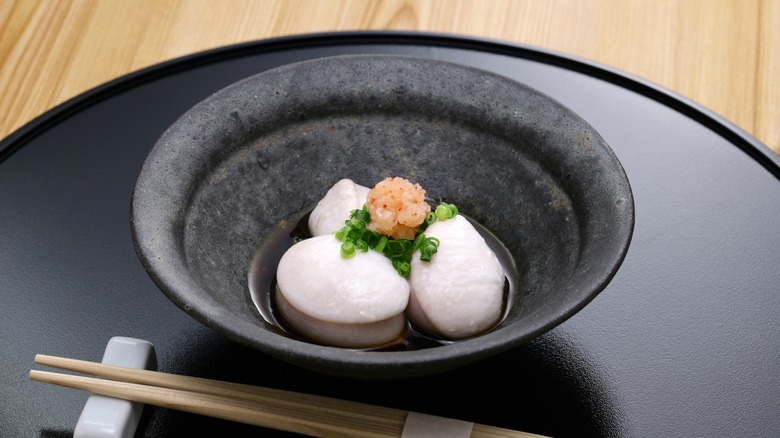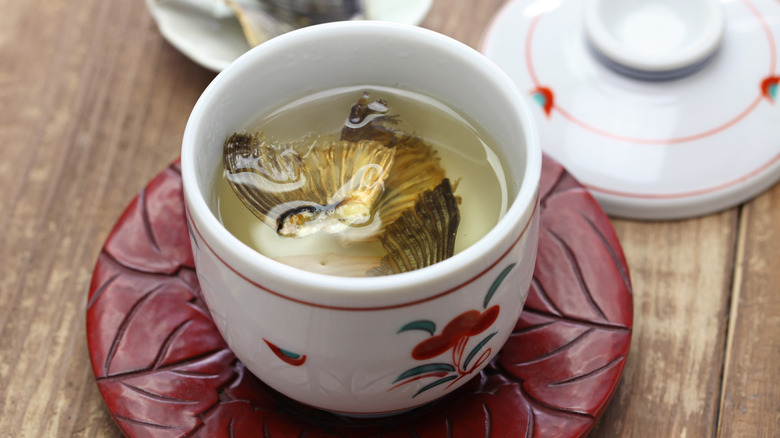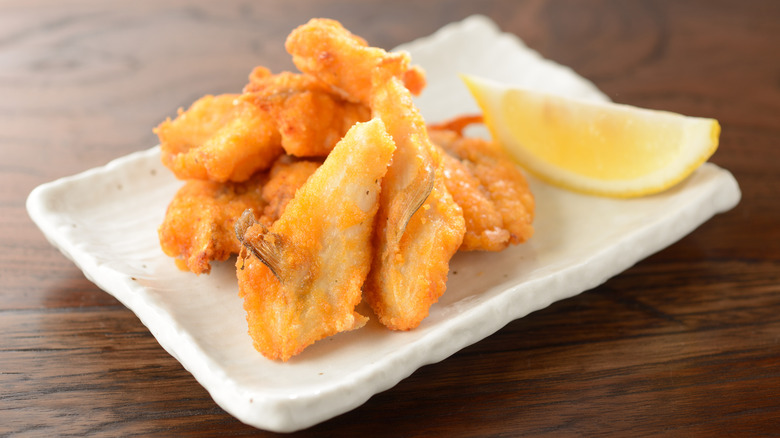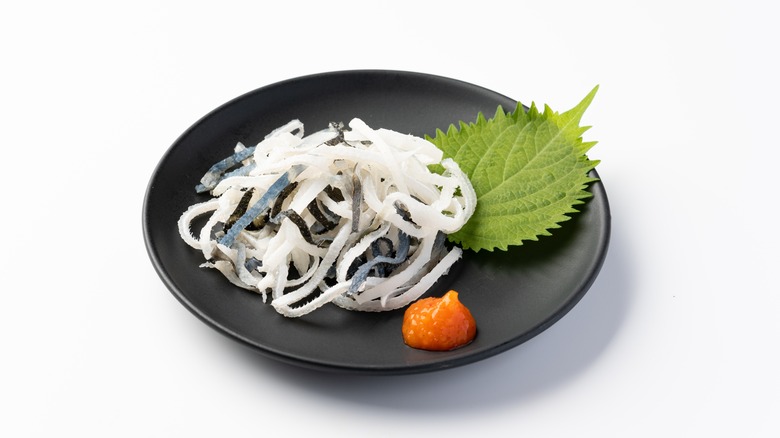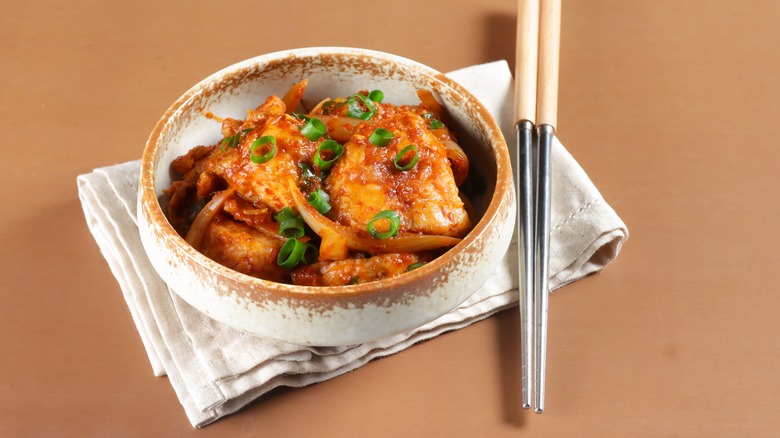What Is Fugu?
Fugu is the most notorious food in Japanese cuisine, and quite possibly the world. It's also known in English as blowfish or pufferfish, and certain parts of the fish themselves do indeed contain potentially fatal toxins. As a result, it needs to be carefully prepared for consumption, and modern Japanese restaurants have strict regulations in place to ensure diners' safety. Becoming a fugu chef is a long endeavor, requiring fine skill and years of proper training.
While fugu may have only become famous worldwide relatively recently, it's long been found in Japanese cuisine. The history this dish in Japan goes back at least 2,000 years and, as you might expect, it has not been without incident. Occasional outbreaks of fugu poisoning have happened in the past, with a particularly bad incident in the 16th century causing the fish to be completely banned for a while.
Traditionally, it's enjoyed as part of Japanese winter cuisine, reflected in the way it's often served. One of the most popular ways to enjoy fugu is in nabe, a hearty Japanese hotpot dish made for sharing with a large group. Diners from overseas may be hesitant, given fugu's reputation, but it's perfectly safe to eat when prepared correctly. The dangerous part is a neurotoxin known as tetrodotoxin, and it's only found in certain parts of the fish's body. Remarkably enough, trace amounts of the toxin are actually said to enhance the experience with mood-elevating effects. Some people in Japan even consider it an aphrodisiac.
What is fugu?
The world's seas and oceans contain hundreds of species of pufferfish, and the waters surrounding Japan contain around 40 different kinds. Fugu's name comes from the fish's defensive trait of puffing itself up when startled. An emergency defensive measure, if the increased size doesn't scare away a potential predator, the spines that cover its skin are likely to keep it safe from harm. Covered in sharp spikes, a fully puffed-up fish temporarily looks something like a pincushion with fins!
The fact that there are so many kinds of pufferfish is one of the reasons fugu can be dangerous when prepared by anyone who isn't an expert. The poisonous parts vary by species, so a part that's safe to eat in one type of pufferfish can be deadly in another. In Japan, the favorite variety is known as torafugu, meaning "tiger fugu" because of the characteristic patterns on its skin (though they often look closer to leopard spots than tiger stripes). This particular type of fugu is said to have the best flavor.
What does fugu taste like?
For all the fanfare about fugu being a famous delicacy, many people are somewhat underwhelmed when they first try it, with some Western food critics describing it as having no flavor at all.. Even some Japanese fugu chefs will admit that they found the exceptionally mild taste of fugu a bit disappointing at first.
It doesn't have the same deep flavor as other popular fish eaten in Japanese cuisine, like fatty tuna or salmon. Instead, the taste is extremely light and subtle. The texture is very different too. While tuna sashimi has a soft, melt-in-the-mouth feel, fugu is a lot leaner and slightly chewy. When cooked, it has a meaty, almost chicken-like texture.
While it may not seem too dissimilar to other types of white fish at first, there are subtleties to the taste of fugu that more experienced diners notice. It's something of an acquired taste, with the more delicate aspects becoming more noticeable over time. Chefs note that both the taste and texture are actually quite distinctive and unlike most other fish.
Part of the reason the taste of fugu is seemingly so subtle is that the major flavor in it is umami, the famous fifth flavor. The meat of this fish is packed with glutamic and inosinic acid. With higher levels of these than other fish, fugu has a particularly rich umami taste, which is a big part of why it's so popular in hotpots, where it fills the broth with flavor.
How is fugu prepared?
Quite simply, fugu must be prepared carefully! Close attention needs to be paid by the chef to ensure it's safe to eat, and this involves knowing both how to cut it and exactly what variety of fish it is. Skill is also required to remove the internal organs before serving, as these are the most dangerous parts.
In particular, the deadliest parts of fugu are the liver and ovaries, often easily containing enough toxin to be fatal. This must also be done delicately, because a misplaced stroke of the knife can easily damage them. If these organs are ruptured before being removed, it could potentially poison the entire meal. Alongside the internal organs, chefs often also carefully remove the eyes, and sometimes the skin, which can also be toxic. The skin is one place where it's important to know what kind of fugu is in the kitchen, because it's edible only in some species, and is often included on the menu.
Where to order fugu
On the streets of Tokyo, fugu restaurants are easy to spot. In the busy streets of places like Shinjuku and Shibuya, fugu restaurants typically have a large aquarium tank full of live fish, sometimes even filling the entire front window. Smaller restaurants may be less showy, but they still typically have a tank on full display for the customers to see. The reason the best Japanese fugu restaurants have live fish on site is so that the meal can be prepared as fresh as possible, those these meals don't come cheap.
Outside East Asia, it may be more difficult to find a restaurant that serves fugu. The reason is fairly obvious: Qualified fugu chefs aren't easy to find. However, there are a few places in North America where the fish can be found on the menu, particularly in big cities like New York. Diners should be careful to find a restaurant with a good reputation, however, as there have been cases in the past of fugu restaurants in the US failing to meet FDA regulations. When a meal is deadly when prepared incorrectly, wise diners should always do their homework first.
In other parts of the world, fugu may not be available at all. Restaurant goers in Europe, for example, are out of luck — fugu is banned across the EU. For people in these countries, the best option is to take a holiday to Japan to enjoy it served by experts.
Nutritional information about fugu
The most immediately noticeable thing about fugu is that it's much leaner than oily fish like salmon. While this means it's lower in calories, it also means it's lower in omega-3 oils. Fugu is low in fat, and most of the fats it contains are polyunsaturated. In addition, it's a rich source of protein and essential amino acids, such as leucine, which is important for muscle growth and recovery, and in regulating blood sugar levels. It's also rich in taurine. Additionally, fugu contains a few important minerals, such as potassium and iron, and the skin is rich in selenium.
Overall, fugu is quite a nutritious food, and the Japanese favorite torafugu (Fugu rubripes) is the most protein-rich of the varieties served in restaurants. Also, notably, fugu has the highest levels of toxins in spring and summer. It's probably best to follow Japanese tradition and eat it during the winter months.
Death by fugu
Fugu is infamous as a dangerous food, and this reputation is certainly not unwarranted; there have indeed been numerous deaths due to fugu consumption. In fact, fatalities have been quite common at some points in history, with around one death per week reported during the 1980s. In modern times though, with stricter regulations in restaurants, the number of fatalities has fallen considerably. While restaurants are typically safe to eat at, one thing that skews the statistics is that there's nothing to stop people from preparing it at home or eating it while out on fishing trips. Domestic preparation of fugu does sometimes lead to deaths, so it's best to leave it to the experts, even if you have the opportunity to cook it yourself.
According to Case Reports in Medicine, tetrodotoxin, the deadly pufferfish poison, can cause headaches, nausea, and disorientation in small amounts, but larger doses can cause muscle paralysis. This becomes dangerous if someone's respiratory muscles become paralyzed, leaving them to asphyxiate. The first warning sign to watch for is usually a feeling of numbness.
In a typical year, there may be around 30 incidents of fugu poisoning reported in Japan. Deaths, however, are now quite rare. The most high-profile cases in the past have been caused by people insisting on eating fugu liver. While it's now illegal to serve this in restaurants, some people consider the liver to be a delicacy. Unfortunately, it's also the most dangerous part to eat.
Non-toxic fugu
Perhaps, surprisingly, the fish themselves are not actually poisonous at all. The poison isn't created in the fish's body, but instead comes from the fugu's diet, mostly from the shellfish they eat in the wild. This gradually accumulates, mostly in the fish's liver, as well as its ovaries and sometimes its skin. Because fugu are effectively poison sponges though, this toxin is inextricably linked to it. Even the name, tetrodotoxin, derives from the name of the fish — the scientific name for an entire pufferfish family is tetraodontidae.
Because the toxin comes from the fish's diet though, this means that fugu can be reared in aquariums and kept away from any dietary sources of it. Fish that are raised this way can be completely poison-free, meaning that even the normally deadly fugu liver can be safe to eat. This has historically been a bit controversial, however. Some Japanese authorities have still been reluctant to remove bans on serving fugu liver, even from non-toxic fish raised in this manner.
Fugu sashimi
Sashimi is a quintessentially Japanese seafood dish of sliced uncooked fish, so it's no surprise that fugu sashimi is one of the things you're most likely to see on the menu. Unlike the more common types of sashimi though, like tuna or mackerel, fugu sashimi is sliced extremely thin. So thin, in fact, that it will be translucent enough for you to see the pattern on the plate through it. This is a particular style of sashimi called usuzukuri, and the reason fugu is sliced this way comes down to the texture of the fish. Fugu has much denser meat than many other types of fish, which means it's a lot tougher. Even thinly sliced, it has a very different, chewier texture than other types of sashimi.
Fugu sashimi is also served slightly differently than other types of sashimi. Where most varieties are laid out in a line, chefs usually arrange fugu sashimi artfully, in a circular pattern like the petals of a flower. It's also served with a different sauce. While most sashimi is dipped in shoyu soy sauce, fugu is usually served with ponzu. This is a rich and flavorful sauce made from shoyu and dashi stock, and flavored with the sharp taste of sudachi — a type of citrus fruit that's often quite difficult to find outside Japan and has a taste similar to a lime.
Fugu nabe
In winter, people across East Asia enjoy hotpot meals. These typically involve a large bowl of boiling hot broth placed in the center of the dining table. Diners are brought plates of raw ingredients that they can drop into the pot themselves to boil until they're cooked. One much-loved type of Japanese hotpot is called nabe. It's a comforting meal during cold Japanese winters that gains a deeper flavor the more meat and vegetables are cooked in it.
With fugu nabe, chunks of fugu fillet take pride of place. As they simmer in the broth, they impart the whole meal with a wholesome umami flavor, giving a deeper taste to any vegetables also added to the pot. While many other types of fish would rapidly start to flake in hot broth, fugu meat is denser. Like swordfish, it holds its shape much better when boiled. Fully cooked, it has a texture that's quite meaty, but also tender and rather fluffy.
Fugu shirako
Shirako is a dish that some beginners may be hesitant about, and many may well find it something of an acquired taste. Sometimes called "soft roe" or "milt," it's actually the fish's sperm sac. Many people consider this one of the tastiest parts of the fish, with a mild flavor and soft, creamy texture.
Shirako from various different fish are served in Japan, and fugu is no exception. It can be found on menus prepared in a variety of ways too. Fugu shirako is sometimes added to nabe or deep-fried as tempura. It's also quite common to see it served raw, seasoned with ponzu and wasabi. For many though, the preferred way to eat shirako is lightly grilled.
Newcomers may be tempted to pass on this particular cut, but many people in Japan consider fugu shirako a fine delicacy and one of the most prized parts of the fish. If you see it on a menu, it's certainly worth a try.
Hirezake
There are a few alcoholic drinks in Japan that may seem slightly bizarre to outsiders, and hirezake is definitely one of them. This warm beverage is made by lightly toasting a fish fin, most often a tail fin, and placing it to infuse in a cup of hot sake — more properly called nihonshu inside Japan. It can be made with the fins from a number of fish, but you're most likely to see it on the menu in a fugu restaurant, and it's often considered an essential complement to the meal. Steaming with alcoholic vapor, more showy restaurants may even light it on fire when they bring it to the table, but this is entirely optional.
It's usually made with robustly-flavored sake (the more delicate ones taste far better served cold), and the umami flavor of the fish complements the savory taste of the sake very nicely. It has a faintly fishy aroma with some light, smoky notes. Overall, even though it's served with the fish fin left inside the cup, the flavor of this drink is quite subtle and, when combined with the warmth of the sake, makes an excellent way to cleanse your palate and round off a filling meal.
Deep fried fugu
Those who prefer a more robust flavor and crunchier texture in their meal might enjoy the heavier taste of deep-fried fugu. There are a couple of different ways it can be served, such as making it into tempura. A kind of light fritter, tempura is best served freshly cooked when it's still lightly crispy. It's often served in a bowl, on a bed of rice, and drizzled with a sticky sauce in a dish called ten-don. While it's more common to see shrimp or sliced lotus root made into tempura, fugu tempura is sometimes served too. However, it's more common to find this served on its own, so diners can focus on the taste of the fish.
Alternatively, fugu can be deep fried as karaage. Where tempura is light and delicate, karaage has a much heavier, more robust flavor. In Japan, karaage usually means fried chicken and it has a crunchy exterior while the meat is soft and juicy. It's not uncommon to see fugu served this way too, though diners should be aware that fugu karaage may still contain bones.
Yubiki
In Japanese cuisine, any cut that can be eaten usually is, and this is as true of fugu as well. While fish skin may not sound appealing at first, fugu skin is often found on restaurant menus. Known as yubiki, this dish consists of fugu skin that is cleaned and cut into thin noodle-like strips before being boiled. Fugu don't have scales, though it takes some skill to properly remove all of the spines. Expert chefs accomplish this with a single swift movement of a knife.
Yubiki is often eaten on its own or included in a salad; it can even be used as a garnish for a plate of fugu sashimi. However, this is a dish that requires a knowledgeable chef. Fugu skin can sometimes be poisonous, and there are a few species of pufferfish in which the skin is not safe to eat. All the same, expert Japanese chefs know exactly what they're doing, and yubiki is quite a popular dish. It's common to see it served as a starter on the set menus in fugu restaurants. The flavor, as with the rest of the fish, is very mild, and it has a chewy, slightly gelatinous texture.
Korean fugu dishes
In Korea, fugu is known as bogeo and is prepared with the characteristic blend of flavors for which Korean food is famous. The more robust notes of this cuisine complement the rich umami taste of the fish very nicely, and one dish you may find in Korean restaurants is bokguk, a type of soup. This hearty dish is filled with the sharp flavors of bean sprouts and green onions and it's sometimes served with the spicy addition of red chili — enough to add some bite, but not so much that it overpowers the taste.
Bogeo is also popularly pan-fried after being marinaded with bulgogi seasoning in a dish called bokbulgogi. Flavored with gochujiang and red peppers, it's a fragrant and lightly-spicy dish with a reddish-brown color; it's slightly chewy on the inside but with a satisfyingly crisp exterior. Alternatively, another way bogeo is served in Korea is in a braised fish dish called jorim. Spiced with chili peppers and typically cooked together with onion and white radish, this dish can be made with any white fish and, while it's usually made with cod, the meaty texture of bogeo works very nicely in it.
